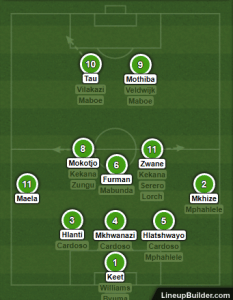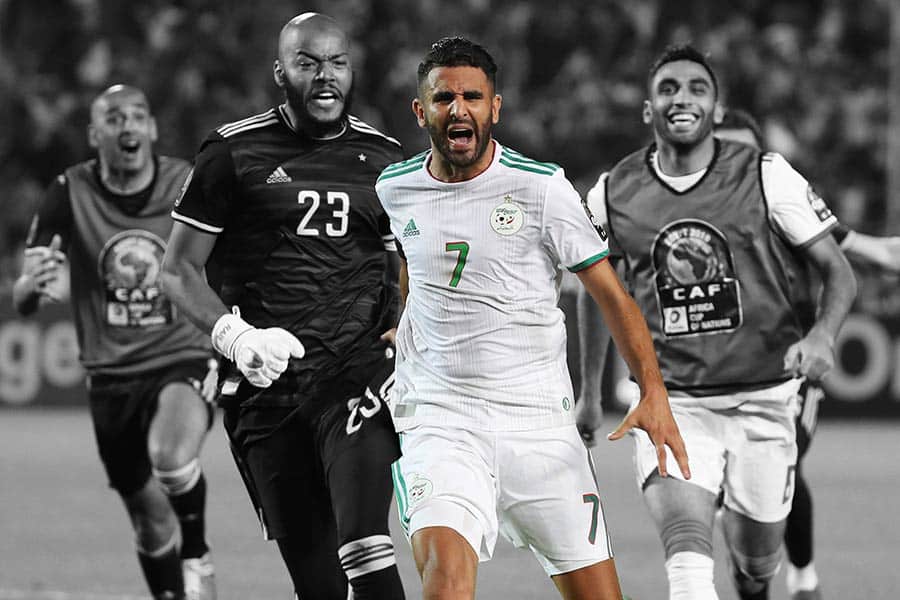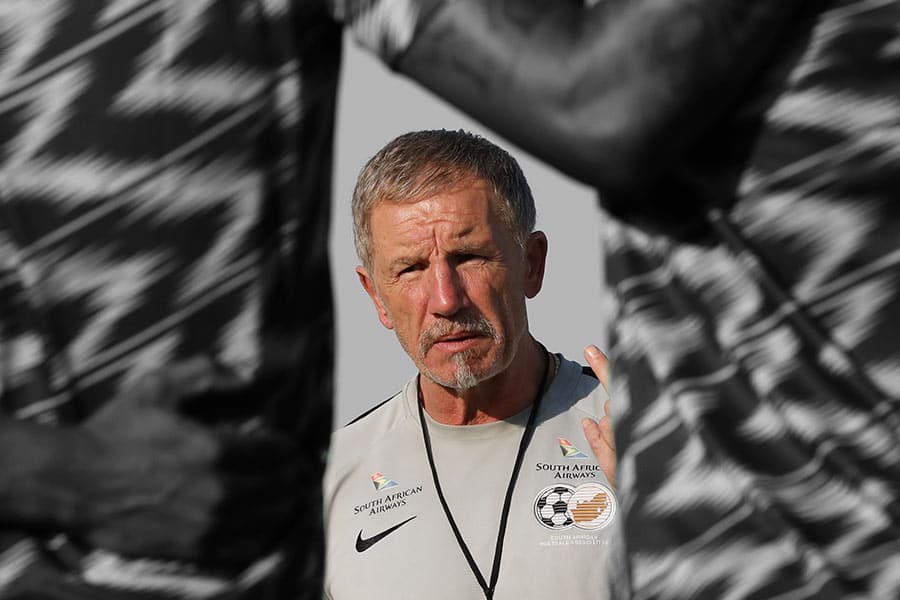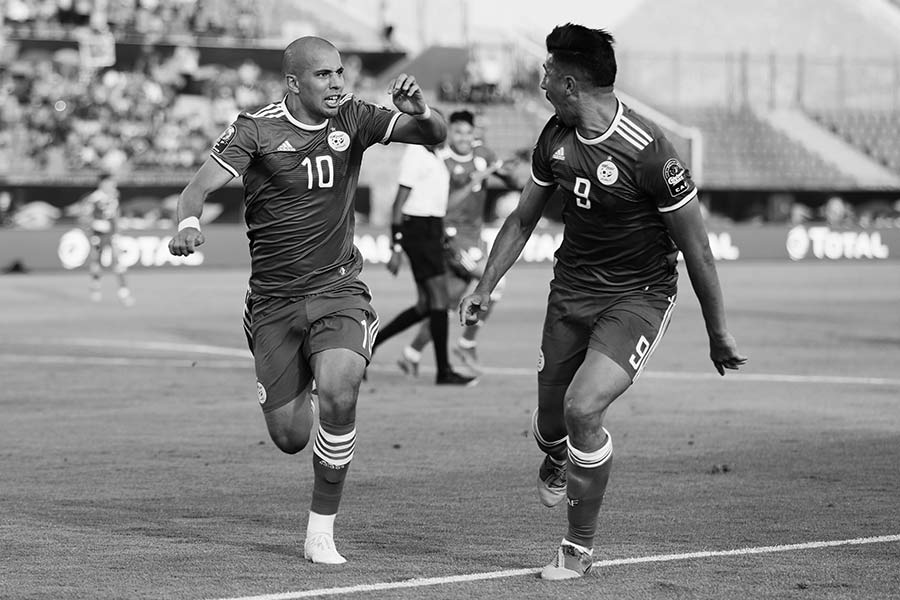
20 June 2019, by: Grant de Smidt
BAFANA BAFANA AFCON 2019 TACTICAL PREVIEW
Ahead of AFCON 2019, we looked at the tactical implications behind Bafana Bafana’s upcoming campaign. In the African Cup of Nations Group D, they’ll face Morocco, Ivory Coast and neighbours Namibia.
BET:
When Stuart Baxter announced his squad, there were immediately a few key tactical talking points. Firstly, he mentioned that both Sifiso Hlanti and Ramahlwe Mphahlele were in the squad as possible central defensive options. Neither is likely to play in the middle of a back four, so his comment suggests a back three is a serious consideration.
When Bafana travelled to Tunisia to face Libya in March, needing a draw to qualify for the showpiece, three central defenders (with wingbacks) were used. Without a natural winger in the 23-man squad – a problem position in South African football right now – it is even more likely that the width will come from either the fullbacks or wingbacks.
Official Bafana CAF squad list
I didn’t know the middle names of some of the guys abo “Caleb” ?????
— Just Prince (@PrinceSobayeni)
Another interesting note from the squad was a deviation from the traditional approach many coaches use to select their squad – three goalkeepers and then effectively two starting XI’s positionally. Instead, Baxter has selected seven midfielders, four or five deep-lying midfielders, numerous attacking midfielders, two target men and the undoubted talisman, Percy Tau.
The reason this is notable is that it does not allow for balanced 11v11 training matches for tactical training. This is a hindrance as South Africa could only secure a single pre-tournament friendly (a 0-0 draw with Ghana with every outfield player getting 45 minutes).
Aside from only having one friendly to prepare, it has not been a smooth preparation period for Bafana. Having given the players three weeks off after the domestic season, Bafana has had just less than three weeks to train together. As seen in the Champions League and Europa League finals, when players go three weeks without playing, match fitness takes a major dip.
That issue is exacerbated by how many players in the squad did not play for their clubs in the final weeks of the season. Kamohelo Mokotjo, Dean Furman, Thulani Hlatshwayo and Percy Tau all missed their sides’ final 2-3 matches. They would not have played a competitive game for two months when AFCON kicks offs.
Striker Lebo Mothiba ended the Ligue 1 season with just two goals in his final 18 appearances. Before that, he hit eight goals in his first 17 league outings.
Angola has cancelled today’s practice match with Bafana Bafana citing lack of training as the reason. Angola says they have not had any training since arriving in Egypt two days ago. — Bafana Bafana (@BafanaBafana)
When coaching Kaizer Chiefs in 2013, Baxter commented on Bafana’s style, saying:
“It’s quick, there’s pace and we’re attaching a little bit of emphasis on our defending, and therein, we’re getting more transitions and I think that’s an interesting way of playing for South Africa.”
That quote could just as easily have been uttered today, such is Baxter’s consistency of philosophy during his time in South Africa. His Chiefs, SuperSport United and Bafana Bafana sides (in both spells in charge) are focused on a good defensive shape, drawing the opponents onto them and then using transitions to hurt opponents before they recover their positions. His midfielders are always encouraged to play the first pass forward after winning the ball. Players like Reneilwe Letsholonyane and Dean Furman took this clear instruction on board perfectly.
Stuart Baxter got his tactics and selection spot on with Darren Keet immense! sat back and caught Libya at crucial moments as the stats show…
— Baden Gillion (@BadenGillion)
In qualifying, South Africa did not lose a match and conceded just two goals. There is little emphasis on dominating possession or playing out from the back. Short build-up play is not expected to be seen with Darren Keet instead hitting long left-footed diagonals. The loss to injury of Itumeleng Khune gives the side less ball-playing ability in goal, especially for quick, accurate distribution to launch counter-attacks.
In football, communication is the most crucial aspect of any team. This refers to how players interact with each other verbally and non-verbally using their teammates, the opposition, their position and the ball as a reference.
The issue for most international coaches is the limited training time, so building understanding and interplay between players is difficult. This usually leads to disjointed football at major international tournaments. Baxter has wisely picked several established club partnerships to “borrow” this communication. In defence, he has a Bidvest Wits goalkeeper behind three of his club teammates.
Further forward, two Mamelodi Sundowns midfielders (and one former teammate of theirs, Bongani Zungu) have been selected. There are three also three current Masandawana attackers, as well as Percy Tau.
Going through their paces on Wednesday at Cairo’s Aero Sports Arena — Bafana Bafana (@BafanaBafana)
The most used formation for Baxter since he took over Bafana has been a 4-2-3-1 formation. With the dearth of form wingers in the PSL, Baxter is likely to have three fairly narrow players behind a frontline striker.
In goal, Keet is expected to start, whilst Thami Mkhize, Thulani Hlatshwayo, Buhle Mkhwanazi and Sifiso Hlanti all should start. In midfield, Furman is a trusted soldier for the coach. Alongside him, Zungu was the incumbent for the first part of qualifying until his knee injury limited him to just 231 minutes all season at Amiens. It is therefore expected to be Mokotjo as the second defensive midfielder.
Further forward, Lebo Mothiba will lead the line with Percy Tau and two of Themba Zwane, Thembinkosi Lorch or Thulani Serero in support. The latter has converted into a deep-lying midfielder at club level and may no longer be best-suited to a number ten role.

Baxter’s other potential formation is most suited when Bafana are playing for a draw. In a format where the four best third-placed finishers in the groups make the last 16, four points could be enough to qualify. Therefore, a draw against Côte d’Ivoire or Morocco, and a win against Namibia may be all that’s needed.
The 3-5-2, consequently, looks ideal for one of the first two matches. With the extremely dangerous Ivorian wingers, Nicolas Pepe and Wilfried Zaha to deal with, Bafana will invariably end up with a back five so the opener may be the wrong game to change shape.
In this formation, Innocent Maela will come in as the left wingback, with Hlanti playing on the left of the back three. One of the two players joining Tau behind Mothiba would then miss out. Most likely, is that Zwane would keep his place as one of the central midfield three, with Tau playing as a channel-running forward.

Undoubtedly, South Africa’s best player is Percy Tau. He has won back-to-back Player of the Season awards at club level and scored four times in qualifying whilst also brilliantly assisting Mothiba’s goal against Nigeria.
However, in a 4-2-3-1, he is invariably shifted into a deeper, wider role which comes with defensive duties. After the friendly against Ghana, Baxter admitted to issues in trying to defend compactly in order to free Tau to play in advanced areas:
“We asked Tau to play a slightly different role today and our midfield players and defenders didn’t really defend the way we wanted them to do, meaning Percy had to drop back.”
Percy Tau has been named the Proximus League Player of the Season after his Phenomenal season in Belgium’s second tier ???
— BET.machibet777-affiliate.com (@betcoza)
In South Africa’s 1-1 home draw with Nigeria in November, Tau had 20 fantastic first-half minutes. He spent the rest of the half trying to track the opposition’s wingbacks and was ineffective. At club level, Tau’s outings as a false nine for Sundowns and then as a second striker for Royale Union Saint-Gilloise showed that he has to be used centrally to be at his best.
In a 3-5-2, he would be able to lead counter-attacks, work his favourite right half-space and have the freedom to move across the frontline when the chance arises. For that reason alone, it may be the best formation for the team’s best player and one Baxter eventually settles on. However, a massive onus will fall on the midfield three to shift laterally across the pitch to help their wingbacks to defend in wide areas.
After a strong qualifying campaign and only trailing for 16 minutes across the six games, Baxter has not had to chase games from a losing position. His selection of Lars Veldwijk is geared towards having a plan B, albeit a route one fall-back. The Dutch-born forward scored mostly close-range headers and tap-ins. He hit 24 goals in 41 games in the Dutch Eerste Divisie last season. However, his form dipped and his final 24 games yielded just eight goals.
Lars Veldwijk has just scored a scintillating hat-trick in a practice game played between two Bafana teams. His first two were impressive volleys and the third was from the spot. Is looking good! — Bafana Bafana (@BafanaBafana)
Beyond him, Lorch and Maboe were two of the best players in the PSL season and both could be excellent substitutes in the 4-2-3-1 shape (assuming neither starts). One major drawback with the 3-5-2 is how to turn the game once trailing. Neither of the wingbacks are particularly threatening and removing a defensive midfielder for an attacking one would leave the middle too open. Therefore, Baxter will have little choice but to move to a back four if the side needs a goal.
It won’t be an easy group stage for Bafana to navigate, but considering the tough draw, it may be advantageous to have a pragmatic, transition-focused coach against superior opponents. The players have bought into this style of play under Baxter so far. There is seemingly a very good team spirit thanks to the club connections.
It unlikely to be aesthetically pleasing to watch Baxter’s side, but if they can get as far as the quarter-finals, it can only be seen as a successful tournament. The irony of his style of play is that it would not be a surprise to see South Africa avoid defeat against both the Ivorians and the Moroccans, but struggle to beat Namibia when needing to play on the front foot.
BET:
BET:

















